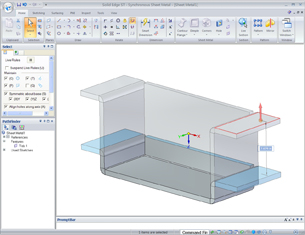Direct Modeling versus Parametric Modeling: The Historical Debate Continues
It's been a year since Siemens PLM unveiled the first incarnation of Synchronous Technology, but the debate over its advantages proves enduring, sustained in part by bloggers and reviewers.
Latest News
May 28, 2009
By Kenneth Wong
It’s been a year since Siemens PLM unveiled the first incarnation of Synchronous Technology, described by the company as “a new way to interact efficiently, intuitively, and directly with parametric, history-based models without being confined to the way the model was constructed” (the words of Siemens’ executive VP of product Chuck Grindstaff on the day of the inaugural Web cast). But the debate over its advantages proves enduring, sustained in part by bloggers and reviewers.
This month, with Siemens’ announcement of the upcoming Solid Edge with Synchronous Technology 2, the controversial CAD paradigm celebrates its first anniversary. The fireworks it ignited among admirers and skeptics alike continues to crackle today.
Retracing History
In April 2009, Desktop Engineering published “Examining Solid Edge Synchronous Technology from a Parametric Point of View,” authored by Matt Lombard, a SolidWorks user steeped in the history-based or parametric-modeling tradition. In it, he acknowledged, “One weakness of history-based systems is that the features in the history tree are recalculated when the part changes, which can take a lot of time for a large number of features … One advantage of direct modeling is that it does not have the overhead of a process … It also does not have to rebuild at every change, thus avoiding potential failures.”
Lombard sees Synchronous Technology and other direct or explicit modelers like SpaceClaim as an alternative to history-based modeling. He observed in his blog Dezignstuff that, “History systems aren’t going to go away, but they are going to get more direct edit functionality” (“SWW09: Bits and Pieces,” February 15, 2009).
 Fig 1. Solid Edge with Synchronous Technology 2, which marks the second incarnation of Siemens PLM’s direct-modeling technology for midrange CAD, introduces sheet-metal creation tools. |
An Alternative Version in Development
Feeling the pressure to respond, Autodesk announced in February 2009 that it would soon deliver a new version of Autodesk Inventor, dubbed Inventor Fusion. (“Autodesk Joins the Hybrid CAD Movement with Inventor Fusion,” February 5, 2009). Set to compete with the likes of Solid Edge with Synchronous Technology and SpaceClaim, Inventor Fusion was described by Autodesk Manufacturing Solutions’ VP of CAD/CAE Andrew Anagnost as “a system that lets you use both the big, heavy mode, and the light, nimble mode.”
With Siemens’ Synchronous Technology, if you decide to use the new modeling paradigm, you’ll have to commit to the new data structure, along with the loss of the history tree. Autodesk claimed Inventor Fusion would allow you to flutter back and forth between the history-based mode and the directing-editing mode. Inventor Fusion is expected to appear as a technology preview at Autodesk Labs in the near future.
Upon returning from the COFES 2009 conference, blogger Deelip Menezes reported Inventor Fusion was set to debut in May. As his source, he cited Buzz Kross, senior VP of Autodesk Manufacturing Solutions. May has come and gone, but Inventor Fusion remains no more than a series of concept videos housed at www.inventorfusion.com.
Nevertheless, Menezes wondered if “Inventor Fusion will be the final straw for SolidWorks.” He suspected Autodesk’s hybrid CAD initiative might “finally make big brother Dassault ]SolidWorks’ parent company] let them ]SolidWorks] use their ]Dassault’s CATIA] V6 direct editing technology.”
The Comment War
Menezes’ post prompted a series of responses, including one from Roberto Ciarloni, the CTO of think3, who wrote, “Direct modeling will never replace history modeling. It will complement it.” Alibre Design’s CEO Paul Grayson jumped into the fray with a rhetorical question: “Why should Alibre, or SolidWorks for that matter, waste development resources on features that their customers are not asking for? Hopefully, we are not expected to write code solely based on what our competitors do and the opinions of industry pundits.”
The defense for SolidWorks came from an unexpected corner. Blake Couter, cofounder of SpaceClaim, a company that markets a direct modeler by the same name, wrote, “Direct modeling is absolutely not a replacement for history-based modeling. For example, I think SolidWorks has done a great job bringing the interaction of direct modeling to history-based modeling with Instant3D.”
Paul Waddington, another visitor, wrote, “Arguing one method of modeling/]drafting] over another is counterproductive and at odds with what we do! … We need a tool, or a seamless set of tools, that allow sketching, 2D drafting and 3D modeling, both ‘history and non-history,’ etc., used in any order, not one or the other.”
For many, a CAD package is not just a software package. It’s a way of thinking and working, perhaps a design philosophy unto itself. Switching to a new modeling paradigm might prove just as difficult as adopting a new identity. But the debate suggests a new CAD modeling paradigm—2D, 3D, direct, explicit, freeform, or a combination of all—will be welcomed by many, provided it can help designers do the same job easier and better.
If you’d like to weigh in on this issue, please visit Kenneth Wong’s Virtual Desktop for the blog post tittled “Synchronous Technology, Take Two.”
Subscribe to our FREE magazine, FREE email newsletters or both!
Latest News
About the Author
Kenneth Wong is Digital Engineering’s resident blogger and senior editor. Email him at [email protected] or share your thoughts on this article at digitaleng.news/facebook.
Follow DE





